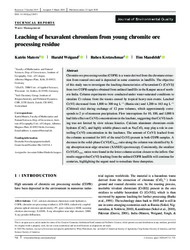Leaching of hexavalent chromium from young chromite ore processing residue
DOI: https://doi.org/10.1002/jeq2.20071
Persistent URL: http://resolver.sub.uni-goettingen.de/purl?gldocs-11858/8810
Persistent URL: http://resolver.sub.uni-goettingen.de/purl?gldocs-11858/8810
Matern, Katrin; Weigand, Harald; Kretzschmar, Ruben; Mansfeldt, Tim, 2020: Leaching of hexavalent chromium from young chromite ore processing residue. In: Journal of Environmental Quality, Band 49, 3: 712 - 722, DOI: 10.1002/jeq2.20071.
 |
Dokument öffnen: |
Chromite ore processing residue (COPR) is a waste derived from the chromate extraction from roasted ores and is deposited in some countries in landfills. The objective of this study was to investigate the leaching characteristics of hexavalent Cr [Cr(VI)] from two COPR samples obtained from unlined landfills in the Kanpur area of northern India. Column experiments were conducted under water-saturated conditions to simulate Cr release from the wastes caused by tropical heavy-rain events. Leached Cr(VI) decreased from 1,800 to 300 mg L−1 (Rania site) and 1,200 to 163 mg L−1 (Chhiwali site) during exchange of 12 pore volumes, which approximately corresponds to 2 yr of monsoon precipitation. Flow interruptions for 10, 100, and 1,000 h had little effect on Cr(VI) concentrations in the leachate, suggesting that Cr(VI) leaching was not limited by slow release kinetics. Calcium aluminum chromium oxide hydrates (CAC), and highly soluble phases such as Na2CrO4 may play a role in controlling Cr(VI) concentration in the leachates. The amount of Cr(VI) leached from the columns accounted for 16% of the total Cr(VI) present in both COPR samples. A decrease in the solid-phase Cr(VI)/Crtotal ratio along the column was identified by X-ray absorption near edge structure (XANES) spectroscopy. Consistently, the smallest Cr(VI)/Crtotal ratios were found in the lower column section closest to the inflow. Our results suggest that Cr(VI) leaching from the unlined COPR landfills will continue for centuries, highlighting the urgent need to remediate these dumpsites.
Statistik:
ZugriffsstatistikSammlung:
This is an open access article under the terms of the Creative Commons Attribution-NonCommercial-NoDerivs License, which permits use and distribution in any medium, provided the original work is properly cited, the use is non-commercial and no modifications or adaptations are made.

